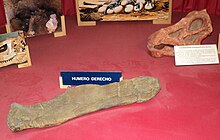Neuquensaurus
| Neuquensaurus Temporal range: Late Cretaceous,
| |
|---|---|

| |
| Holotypic caudal vertebrae | |
| Scientific classification | |
| Domain: | Eukaryota |
| Kingdom: | Animalia |
| Phylum: | Chordata |
| Clade: | Dinosauria |
| Clade: | Saurischia |
| Clade: | †Sauropodomorpha |
| Clade: | †Sauropoda |
| Clade: | †Macronaria |
| Clade: | †Titanosauria |
| Family: | †Saltasauridae |
| Tribe: | †Saltasaurini |
| Genus: | †Neuquensaurus Powell, 1992 |
| Species | |
| |
| Synonyms | |
|
Genus synonymy
Species synonymy
| |
Neuquensaurus (meaning "Neuquén lizard") is a genus of saltasaurid sauropod dinosaur that appeared in the Late Cretaceous, 71 million years ago in Argentina and Uruguay in South America. Its fossils were recovered from outcrops of the Anacleto Formation around Cinco Saltos, near the Neuquén river from which its name is derived.
History

In 1893, Richard Lydekker named "Titanosaurus" australis, based on a series of caudal vertebrae and limb elements. The remains were found in the Neuquen Province of Argentina, and were assigned to one individual.[1] Some elements that were assigned to "Titanosaurus" australis were then reassigned to "Laplatasaurus" araukanicus by Friedrich von Huene in 1929.[1] The same year, Huene named "T." robustus, and claimed it differed from "T." australis by differences in the limb material. Huene described all the slender limb material to "T." australis, but did not say any differentiating features between the vertebrae. When describing "T." robustus, Huene did not readily compare other genera and species to it.[1] The material assigned to "T." robustus was said by Bonaparte et al. to consist of a left femur, both ulnas, and a left radius.[1]
Powell found in 1992, that "T." australis was less similar than "Laplatasaurus" araukaicus to Titanosaurus indicus, and so named a new genus, Neuquensaurus, for the species. He also found "T." robustus to be assignable to the new genus, but considered it non-diagnostical, and so a nomen dubium. Later, the two species were assigned to Saltasaurus by John McIntosh, for McIntosh said the features found by Bonaparte were not of taxonomic importance, and therefore not diagnostic.[1]
Description

This dinosaur is believed to have possessed armor-like osteoderms.[1] A relatively small sauropod, with a femur only 0.75 metres (2.5 ft) long. It is one of the most completely known of Patagonian sauropods.[1] In addition to the original fossils described by Lydekker in 1893, it is represented by fossils collected in the early twentieth century, and more recent material, including a well preserved and partially articulated specimen described in 2005 (with two associated osteoderms),[2] as well as additional undescribed material.
Skeleton
Neuquensaurus has an almost complete skeleton. Among the preserved elements are a scapula. The scapula is co-ossified with the coracoid, a feature also found in Opisthocoelicaudia. In general aspect, the scapula resembles Saltasaurus, Opisthocoelicaudia, Lirainosaurus, and Alamosaurus. The coracoids of the scapulae are roughly quadrangular in shape, and are alike Saltasaurus and Lirainosaurus, but not Opisthocoelicaudia, Rapetosaurus, or Isisaurus, all of which have a rounded coracoid.[1]
Distinguishing characteristics
Many characters distinguish Neuquensaurus from other titanosaurians. The features found by Otero in 2010 are listed below:[1]
- the possession of posterior caudal centra that are dorsoventrally flattened;
- and strongly developed fibular lateral tuberosity.
Classification
Neuquensaurus is a derived saltasaurine. Its closest relatives were Saltasaurus, Rocasaurus, and Bonatitan, and together they made up Saltasaurinae.[1]
Paleocology
Neuquensaurus is known from fossils from the Anacleto Formation.[1]
References
- ^ a b c d e f g h i j k Alejandro Otero (2010). "The appendicular skeleton of Neuquensaurus, a Late Cretaceous saltasaurine sauropod from Patagonia, Argentina" (PDF). Acta Palaeontologica Polonica. 55 (3): 399–426. doi:10.4202/app.2009.0099.
- ^ A New Specimen of Neuquensaurus australis, a Late Cretaceous Saltasaurine Titanosaur from North PatagoniaLeonardo Salgado, Sebastián Apesteguía and Susana E. HerediaJournal of Vertebrate PaleontologyVol. 25, No. 3 (Sep. 30, 2005), pp. 623-634
- Powell, J.E. (1992). "Osteologia de Saltasaurus loricatus (Sauropoda - Titanosauridae) del Cretacico Superior del noroeste Argentino" In: J.L. Sanz and A.D. Buscalioni (editors), Los Dinosaurios y Su Entorno Biotico: Actas del Segundo Curso de Paleontologia in Cuenca. Institutio Juan de Valdes 165-230.
